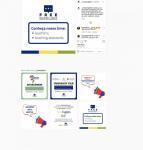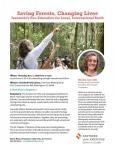My Nonprofit Reviews
Cathy H.4
Review for Partners of the Americas, Inc., Washington, DC, USA
The US State Department calls organizations like Partners of the Americas "soft diplomacy." However, for those of us who want to live international lives with purpose while we are reside where we work, Partners lets you do both. Through my membership, I have enjoyed professional achievements and multi-generational relationships far beyond what I would ever have imagined. So have the friends that I've met through Partners. Not only that, we've had a heck of a good time.
Partners is a great NGO.
Since January, I have been on the Partners International Board. I accepted this position because directors do governance and work with volunteer members throughout the network as well as with staff, including those who administer large US government grants that address such problems in Latin America as child labor. The bridge for the entire organization is our ethos: Our time to helps advance others.
Every Partner I know can give you their story of opportunities. My praise for Partners and what it has given me and others is in two sections: 1) Exceptional opportunities 2) Highlights from last week that prove my point.
Exceptional Professional Opportunities
Through a DC-Brasília Partners project, I won a Reuters Digital Visionary Fellowship at Stanford, which is how I spent my first year after retirement from National Geographic, where I was the co-founder and editor of the Intranet. The project brought together the two NGOs that I had volunteered with for years: Partners of the Americans and iEARN: Learn with the World, a K-12 network of teachers in about 140 countries whose students collaborate.
Almerinda, president of Brasília Partners and a public-school, English-language teacher, was key to my fellowship project. I had introduced her to iEARN when she visited DC on a Partners travel grant. She founded Educadores Globais, an NGO that includes iEARN-Brasil. Almerinda’s work with iEARN helped her get admitted to the highly competitive master’s program in Applied Linguistics at the University of Brasília. She hadn’t made the cut before
Adriana, a member of Patagonia Partners and an English-Language teacher in a public high school, was my first Partners/iEARN friend. During the Argentine financial crash, I told her about an opening with the World Bank in DC. Eventually, she became director of Educational Technology for the Organization of American States. Adriana told me about the Stanford Fellowship.
I have continued volunteering with Partners and iEARN. Even with COVID restrictions, Partners lead lives that are enriched by lending a helping hand.
This capsule from last week is typical. Reminder: This is volunteer “work,” and I have been involved with all of these projects as a catalyst, a connector, and a worker. I was on last week’s zoom calls. This also doesn’t count my regular life in DC.
One Partners’ Life Last Week from An Apartment in DC
1. Jackie, a mid-career analyst in metro-DC, cares deeply about the environment and participates in activities like last weekend’s river bank clean-up by a group in northern Virginia. A long-time Partner, Jackie has just been named the facilitator for Partners’ Community of Practice: Environment. She and I zoomed with Daniel from La Paz. He and Partners members are working on the restoration of Lake Titicaca. He and his team will give Jackie’s next all- Partners webinar.
This action has happened over the past few years, connection by connection. The Bolivians got to know Jackie by attending the first Partners environment webinar that she organized a few months ago. The featured speaker, Binka, is co-founder and co-director of the Iracambi Atlantic Rainforest Research Institute, and a former director of the Partners of the Americas International Board.
One of the needs is to loop in the Utah chapter, which in Partners’ bilateral beginnings, was linked with La Paz and the Altiplano. Utah was starting to be active again but was set back by COVID. Back in touch now.
2. The PartnersCampus chapter in Goiana, Brazil started teaching Free English online to students in many states in Brazil. They need volunteer teachers and assistants. Daianne, a volunteer grad student, is the founding director. This week, she and I held a zoom, with LaShelle, president of DC Partners and a program coordinator at Sasha Bruce Youthwork in DC, which works with at-risk youth. We think that Sasha Bruce’s youth might learn new skills and thrive by using their English language skills to help other low-income youth. Note: Brazilians need either English, Spanish or French to pass the national university entrance exams, and English is essential for several disciplines, especially the sciences.
3. Word came to me via the Society of Women Geographers that Karen, their new president, who also is a Colorado Partner, has been knighted by Senegal for her work in bringing attention to the Joola shipwreck to US audiences. (Joola is the second largest marine disaster in non-wartime history.) I’ve been organizing getting the news out to the full Partners network and on social media. Karen is just back from researching in Mexico on her 7th Fulbright.
4. Manuel, 17, and his mother Monica, (past-president of La Paz Partners) are joining his father/her husband in New Jersey. Manuel has been helping me with my Spanish on my Wednesday tutoring sessions with an Argentine instructor. The other student is 14-year-old, Samantha, a Honduran-American from DC, who is learning to speak academic Spanish. Samantha and I have been spending further zoom time with Manuel, helping with his English as well as what to expect in a US high school.
5. I started monitoring a five-week, iEARN learning circle, Hello, World, designed for teachers who are new to global exchanges. This one is in English. My goal is to gain the skill so that I either facilitate Partners' Hello circles or spend short-term time such as in Honduras to help Partners there, which wants to advance English experience for teachers and students.
6. Partners HQ put out a request for help for two low-medical students from Minas Gerais, Brazil who have been accepted at George Washington University for a six-week course. They need housing, but can’t afford it. We in the metro area are working on helping.
This is what partnering is all about. Or as Partners of the Americas says:
“We bring the right mix of players – volunteers, development professionals, governments, businesses, and higher education institutions – to the table in order to match resources, knowledge, and passion to need. By connecting local organizations to broader funding opportunities and empowering citizens to become agents of change, we develop lasting solutions to our hemisphere’s toughest challenges, together.”
Review for Partners of the Americas, Inc., Washington, DC, USA
Volunteers in Partners of the Americas connect, serve, and change lives. There are as many ways to make good things happen as there are individuals who belong. Partners’ strength is it embraces flexibility and has faith—based on experience—that ripples from service will impact others.
Partners has given me a world of friendships. I’ve been able to serve, and I’ve changed many lives, including my own.
Here’s a taste of how Partners’ three-part mission works:
John Beattie, a retiree in the Colorado Chapter of Partners of the Americas, wanted to improve the English and teaching skills of public-school, K-12 teachers in their counterpart chapter in Minas Gerais, Brazil. The problem: English is a required part of the curriculum there, but few teachers are fluent.
A “skunkworks” personality, John piloted a solution: He motivated his chapter to build a program, which lasted until COVID. Every July (summer vacation in Brazilian schools), 14 teachers flew to Colorado, lived with families, and learned the local community college’s latest teaching techniques. Colorado Partners did deep pocket fund-raising; they paid the college professors and paid for plane tickets for the teachers when needed.
How could lives not be changed? One example: Marcîa Pinheiro, an ELL teacher from Brasília, was accepted for the University of Brasília’s highly competitive Masters in Applied Linguistics degree, now completed. Another: John recruited an ELL expert from the University of Northern Colorado to join the chapter. Soon, Professor Tom Griggs traveled to Minas Gerais to give ELL workshops on a Partners Travel Grant. When he retired, Tom spent last year as a visiting professor at a university in Minas Gerais.
Some volunteers thrive when they carefully create an enduring structure such as the annual Brazilian Film Festival that Illinois-Sāo Paulo State chapters sponsor. Other volunteers use their expertise to educate others, such as Denise Decker, Ph.D. in the DC-Brasília Partners. Denise has been blind since birth. Guide dogs are crucial to her mobility and have been a powerful reinforcement to her lectures on inclusion for chapters in the US and Brazil.
Inspired by President John Kennedy, Partners of the Americas was founded as the people-to-people component of the Alliance for Progress. More than 50 years later, it has evolved from the original concept of linking a US state to a Latin American country (or US state-to-Brazilian State.) Now Partners is more multi-lateral, with volunteers across chapters collaborating in projects with common interests.
I’ve been involved with Partners for more than 30 years and belong to the DC-Brasilia chapter. My pleasure and skill are to inspire teams that open opportunities for others here and there “organically,” meaning one action opens other possibilities, and so on. Our chapters’ most impactful project started when a fellow Partner and I organized a talk by a visiting TV morning show host from Brazil to DC teachers during a day-long workshop arranged by the National Geographic Society. He wowed them.
That led to DC and Brasilia exchanging four groups each of low-income students who earned their way by doing community service projects — with the chapters doing a lot of fund-raising. All, I believe, met with the US Ambassador in Brazil.
At some point, the US Embassy in Brazil started a Youth Ambassadors program for low-income English language students who had to do community service. Now the US State Department’s Youth Ambassadors program was operating, pre-COVID, in at least nine countries.
Most recently, volunteers from multiple chapters, both in the North and South, have been recruiting and training K-12 teachers to incorporate global exchanges into their required curriculum. We are working with the staff at Partners and the International Education and Resource Network (iEARN).
For a fitting “connecting-serving-changing lives” finale: I heard about iEARN when I became a founding member of Patagonia-Montana Partners. (Story for another time.) The first Patagonian Partners teacher that I met was an English-language instructor in a public high school who used iEARN projects in her classes. Today she is the retired director of educational technology for the Organization of American States, and we are still close friends.




